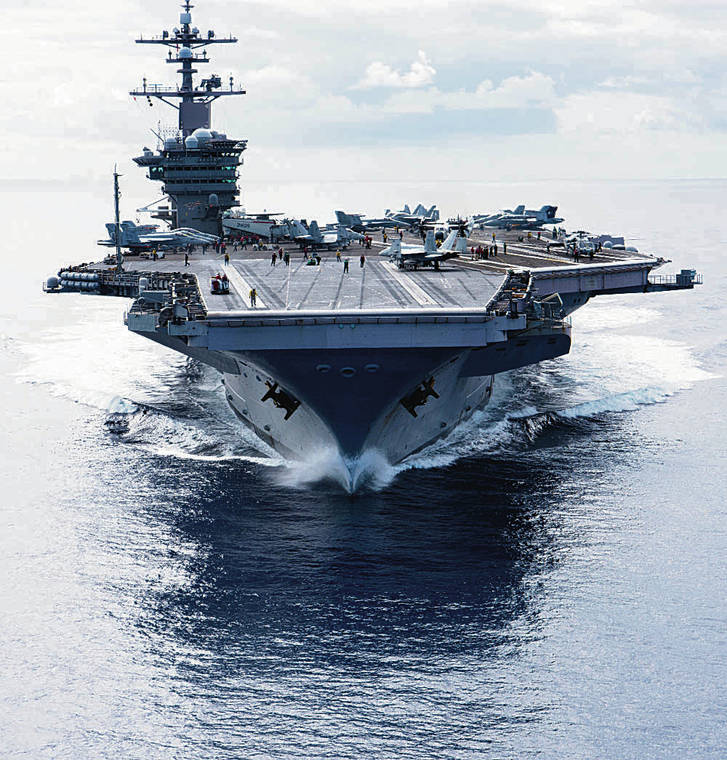A new Navy exercise focused on countering China and Russia in the European and Indo-Pacific theaters — perhaps at the same time — is underway, testing the ability to synchronize five fleets and three Marine expeditionary forces across 17 time zones while also employing fast-moving war-
fighting concepts to combat adversary missile advances.
Large Scale Exercise 2021 signals “to our competitors (that) the U.S. military remains ready for the high end of warfare expressly because of its global commitments, rather than in spite of them,” the Navy’s Sixth Fleet said in a release.
At about the same time, U.S. Indo-Pacific Command, headquartered on Oahu, is running Large Scale Global Exercise 21 incorporating Army, Navy, Air Force and Marine Corps forces alongside elements from the United Kingdom, Australia and Japan.
The global tests come with escalating challenges from Russia and China and are meant to be a sign of greater resolve to protect U.S. interests.
Sixth Fleet, headquartered in Naples, Italy, said LSE 2021 is the first naval and amphibious large-scale exercise conducted since the Ocean Venture NATO exercises launched in 1981 during the Cold War.
Those exercises simultaneously demonstrated NATO resolve and simulated new U.S. maritime capabilities, the Navy said. “The intent is the same for LSE 2021 within the context of modern warfare and during an era of strategic competition,” the Navy said.
A 2018 Naval Historical Foundation article noted, “With the backing of President Reagan, the scheduled NATO exercise for late 1981, Ocean Venture, took on more aggressive objectives, signaling to the Soviet Union that if the balloon went up, American and NATO naval forces would not be passive.”
LSE is part of Large Scale Global Exercise 21, said Lt. Corey Jones, a spokesman for U.S. Pacific Fleet.
The Carl Vinson Carrier Strike Group deployed
Monday from San Diego, headed west for participation in Large Scale Exercise 2021, which runs through Aug. 16, before continuing in support of “global maritime security operations,” the Navy said.
The voyage marks the first operational deployment of a carrier strike group with the advanced capabilities of the F-35C Lightning II and CMV-22B Osprey tilt-rotor aircraft, according to the service.
The strike group of more than 7,000 sailors includes the Hawaii-based destroyers USS Chafee and USS Michael Murphy as well as the destroyers USS Dewey, USS Higgins, USS O’Kane, USS Stockdale and cruiser USS Lake Champlain.
Prior to deploying, the strike group completed training in the Hawaiian Islands operating area with land-based Marine Corps, Air Force and Coast Guard aircraft, as well as operations with Coast Guard cutters.
Meanwhile, the Navy,
using a “Coral Sea” identifying location off the northeast coast of Australia, announced that the USS America expeditionary strike group is conducting operations this week alongside Australia’s HMAS Canberra and HMAS Ballarat and
Japan’s JS Makinami as part of a “combined and joint battle problem” under Large Scale Global Exercise 21, which runs through Aug. 27.
“Throughout numerous locations in the Indo-Pacific region, LSGE 21 will include a field training exercise, logistical and support activities, amphibious landings, land force maneuvers, urban operations, air operations, maritime operations and special operations forces activities to allow U.S. forces to train with allies and partners,” Jones said.
BBC News reported that China warned Britain’s HMS Queen Elizabeth aircraft carrier strike group not to carry out any “improper acts” when it recently entered the contested South China Sea, with the South China Morning Post saying the ship group did not sail close to China’s man-made islands.
China’s hawkish Global Times responded to the “large scale” exercises by saying that “if it wants to confront China and Russia simultaneously, the U.S. does not have such capability.”
It said China announced its own naval exercises today to Tuesday in the South China Sea that will “serve as a response to the recent provocations,” and noted a drill last year in which the People’s Liberation Army test-fired a “carrier killer” anti-ship ballistic missile.

